Rogue One: A Star Wars Story feels torn between two extremes.
On one extreme, it is an epic war movie about a universe that is caught in turmoil. Through the lens of science-fantasy, Rogue One can tease out all manner of interesting ideas about the conflict at the heart of the Star Wars franchise. What does an interstellar war look like in the early years of the twenty-first century? What is the view of this epic confrontation from outside the cockpit of an X-Wing or the Millennium Falcon? There are points at which Rogue One almost plays as a war film that just happens to be set within the Star Wars universe.

Too TIE-d to continuity?
On the other extreme, Rogue One often feels like a collection of deleted scenes intended to bridge Star Wars: Episode III – Revenge of the Sith to Star Wars: Episode VI – A New Hope. The basic premise of the film involves the theft of the Death Star plans that propel the plot of A New Hope, which should be enough to connect it to the parent franchise. Instead, the film is saturated with cameos and callbacks. While it makes sense for a number of minor characters to overlap, Rogue One contorts to include two of the franchise’s biggest characters.
So Rogue One is trapped between being an exciting and exhilarating glimpse of an existing franchise from a new perspective, and feeling just a little bit too much like fan fiction. It is no surprise that the former is much more interesting than the latter.

Watered down?
The most interesting aspect of Rogue One is the sheer potential of the project. Freed from an “Episode” subtitle, there is a sense that Rogue One can play with one of the best-loved media franchises of all-time. It can take the existing framework of the Star Wars universe, that seems coded into the DNA of modern pop culture, and subvert or interrogate it. Imagine a spy movie playing with this world and its characters, or a heist movie unfolding on an epic scale. Imagine seeing the Star Wars universe at a remove from Jedi Knights and Sith Lords.
Star Wars is a monolithic part of popular culture. People know it inside and out, even beyond the fandom. Casual movie-goers recognise the iconography and the mythology. People who rarely go to the cinema can idly hum the theme music to themselves. Yoda and Darth Vader are go-to impressions that are easy to read, even if the impersonation itself is terrible. So the Star Wars franchise is part of the rich cultural tapestry, and something that can be tinkered with.
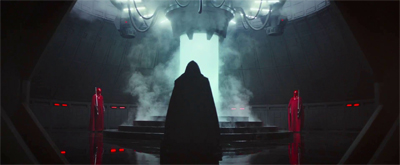
Taking the tube home.
The big epic Star Wars films invite fans to speculate and wonder. The joy of George Lucas’ original creation was the skill with which a single line of dialogue could lead to hours of speculation from audience members. The universe seemed improbably vast, limitless in scope and yet perfectly formed. Watching Star Wars, it was fun to imagine dancing between the raindrops of continuity, to conjure up some sort of pop art version of Rosencrantz and Guildenstern Are Dead to this science-fantasy epic.
Indeed, that was the best part of the infamous decision to scrap the “expanded universe” that had developed in novels and comics and video games around the film franchise. Those secondary and tertiary materials were not erased or diminished by that decision. Those stories about Admiral Thrawn or Prince Xizor did not cease to exist because they were deemed “out of continuity.” Fans who enjoyed those stories could still enjoy them, even if they were disappointed that the Star Wars franchise was no longer beholden to them.

Jyn and gone.
Erasing the expanded universe from continuity was a good decision because it cleared out a whole host of incestuous clutter. When writing tie-in fiction or fan fiction, the impulse is always to build a universe inwards rather than outwards. There is always a desire to connect every meaningful event or character to a piece of continuity or history. Removing all of that material from the so-called “canon” allowed the production team in charge of the revitalised franchise to put their own stamp on events.
There is a lot of Rogue One that works very well in that regard. There are points (particularly in the first half) where director Gareth Edwards seems happy to have cast free of the expectations of one of the “big” or “main-line” franchise films. Early on, Rogue One establishes a number of sizeable formal departures from the Star Wars template. The music is slightly different from the regular overture. There is no title scroll. There are on-screen legends that help to establish key locations through text rather than blunt exposition.

Firing the canon.
These formal departures are small, but meaningful. Over the course of the first hour, Edwards establishes his own approach to the larger Star Wars universe. This is a film that is very much rooted in the background players. These characters are not “chosen ones” or “princesses.” They are footnotes in the larger franchise history. In this respect, it builds upon the most interesting storytelling choices of Star Wars: Episode VII – The Force Awakens.
At its best, Rogue One offers a view of the Star Wars universe from the ground floor. The movie features all manner of classic Star Wars iconography, but the scale seems somewhat larger. These events and these conflicts seem to happen at several levels about the heads of the primary characters. The Death Star drives the plot of the film, and is very much the best example of this. Variants and images of the Death Star have appeared in four of the seven Star Wars films, but Rogue One still finds a way to make the weapon look fresh and interesting.

That’s no moon.
Rogue One looks at the so-called “planet killer” from the surface of the planet. At one point, the Death Star rises over the surface of a planet like a moon. At another point, it positions itself so as to eclipse the sun. When the blast hits, the audience does not witness the destruction from the cold distance of space. Instead, the weapon is portrayed as something very much akin to a nuclear bomb. Two significant characters even get to make a stylised homage to the atomic shadows from Hiroshima or even to the work of Alan Moore and David Gibbons.
This is more than just a clever visual choice. It is a recurring theme of the film. Orson Krennic, the villain of the piece, is constantly framed as a non-entity. Ben Mendelsohn does good work in the role, but his low-key naturalistic delivery (which occasionally even borders on mumbling and grumbling) is consciously at odds with the more theatrical elocution associated with the franchise’s epic bad guys. Krennic is not Darth Vader or Emperor Palpatine, and seems unlikely to be remembered in the same breath. But that is very much the point.

Who’s Stryver now, eh?
Indeed, the most interest aspect of Krennic’s characterisation is his ambition to play at a level beyond his ability. Krennic constantly yearns for the respect and admiration of those iconic bad guys. Testing the iconic weapon, he laments, “The least the Emperor or Lord Vader could do is be here.” Krennic repeatedly insists that his supervisors put in a good word for him with Emperor Palpatine. Those promotions for designing genocidal weapons don’t deliver themselves. Krennic is very much Imperial middle-management, which is in keeping with the aesthetic of the film.
There is an appeal to this approach. Rogue One feels like it might get away with delivering something a bit stranger than any of the more traditional Star Wars films. In particular, the first half of the movie suggests an interesting moral ambivalence to the whole saga. The morality of the Star Wars universe is generally quite clear-cut, in that the Rebels are the good guys who dress in bright colours and fight for vague ideals like freedom and democracy while the Empire dresses in black and acts like Nazis.

“Well, this Christmas Party got out of hand.”
However, there is some interesting subtext to all of this that has never been properly explored. When George Lucas originally developed Star Wars, he imagined the Rebel Alliance as the Viet Cong and the Galactic Empire as the United States. That was a very charged allegory, even buried beneath the Flash Gordon aesthetic. The early years of the twenty-first century have only made the morality all the more intriguing. The Rebel Alliance are basically terrorists. More than that, the Jedi are religious fundamentalists. (Although the Empire are still pretty bad dudes.)
Rogue One teases this idea in the first hour, playing with the notion of the Rebel Alliance as sanitised terrorists. After all, the original Star Wars trilogy never has any concept of collateral damage or moral compromise. Our heroes are never forced to make tough decisions for pragmatic reasons. Rogue One imagine what a more grounded twenty-first century interpretation of that core conflict might look like. Rogue One features a Rebel Alliance that murders witnesses and assassinates collaborators, that bombs busy marketplaces and engages in torture.
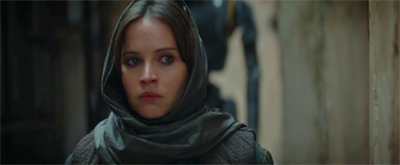
Just deserts.
Midway through the film, Rogue One consciously updates that subtle Vietnam metaphor for the War on Terror. The Empire is hard at work on a desert planet that was once home to the last of the Jedi Knights. Their interest in the planet seems primarily based upon ease of access to natural resources. A random rebel attack upon an Imperial convoy unfolds in broad daylight with little regard for civilian casualties and using improvised explosive devices. It is a thrilling sequence, primarily because it plays with audience sympathies and expectations.
Rogue One even dares to ask to about the moral authority from which these characters operate. Saw Gerrera is introduced as the Rebel Alliance’s counterpart to Darth Vader, a creature who was once a man but is now mostly machine. Disfigured and dismantled by war, his arms and legs are all mechanical like those of the iconic Sith Lord. “There’s not a lot of me left,” he confesses, taking a deep breath from his ventilator in order to cement the none-too-subtle parallels between Gerrera and Vader. Gerrera even tortures his captives. Although he does ask questions.

He came, he saw…
There is a recurring sense of the damage that war does to people, which is a refreshing approach to a franchise called Star Wars. More than any of the other films in the franchise, Rogue One is populated by broken things. Although Bodhi Rook is never fully developed, it is implied that the defector has been psychology scarred by his treatment at the hands of the rebels. The droid K-2SO is suggested to be psychologically unstable after being reprogrammed. The movie asks whether Cassian Andor is being dehumanised in a less literal manner than Saw Gerrera and Darth Vader.
Unfortunately, Rogue One shies away from these bold ideas. The more violent elements of the Rebel Alliance are explicitly as “extremists” who will not compromise with our heroes. There is a sense that Saw Gerrera has transformed into a Star Wars version of Colonel Kurtz and is not supposed to be representative of the movement as a whole. Indeed, the climax of Rogue One shies away from the more intriguing allegorical subtext in favour of a more conventional military confrontation that could easily have come from any other Star Wars film.
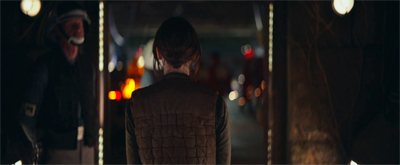
Rebel, rebel.
As it goes on, Rogue One begins to feel trapped by the expectations of its multi-billion dollar franchise. As the movie approaches (and then enters) its third act, it becomes less of an interesting new perspective on a very old media property and becomes more of a conventional Star Wars narrative. The best shots and sequences in Rogue One are those that offer a new way of looking at a familiar property. The least interesting shots and sequences are the direct lifts, like the sentry towers or the hangar bay at the rebel base on Yavin.
Within the franchise, the Death Star has become a fetish object that has inspired two fairly expensive (and deeply flawed) tributes from the Empire and the First Order. However, Rogue One has the luxury of actually featuring scenes on the original Death Star, and it recreates some of those most iconic beats with a slavish devotion to detail. Given the iconography of the Galactic Empire, there is something rather strange and disconcerting about the care that has been taken in recreating certain sequences from A New Hope. It feels almost like a grim ritual or invocation.
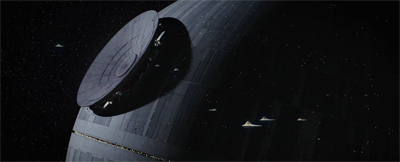
Putting the pieces together.
One of the most technically impressive aspects of Rogue One is the emphasis that the film places upon the character of Grand Moff (or “General”) Tarkin as played by a CGI recreation of Peter Cushing. The computer animation is very good, and it benefits from the fact that no member of the Galactic Empire could ever be faulted for having the sort of cold dead eyes that CGI animation still struggles to avoid. Of course, including Tarkin opens up all manner of interesting continuity related fun, with the movie consciously blurring the nature of his relationship to Vader.
Towards the end of the film, more and more classic character begin to cameo. It would be churlish to discuss those in any great depth, except to acknowledge that most of them are completely unnecessary. Several of these recurring franchise characters could be exorcised from the film with no real loss to plot integrity. If anything, the movie would be streamlined and rendered more effective. Rogue One devotes time and energy to answering questions that nobody ever really cared about, such as “what happened to Red Five before Luke Skywalker took it as a call sign?”

You can have innovation Andor continuity.
These sequences frequently feel like deleted scenes or web-only content, awkwardly winking at the audience in a way that distracts from the story being told. These characters are so iconic and so familiar that their presence exerts a strange gravity over the film. There are points at which it seems like the primary cast of Rogue One are having the movie stolen out from under them, particularly at the end of the film once all of their character arcs have been resolved and the script insists on offering a clumsy epilogue following a secondary player.
This is a shame, as Rogue One would undoubtedly benefit from paying more attention to its expansive cast. Star Wars has never been a franchise particularly rich in characterisation on the page, with the success of characters like Han Solo or Darth Vader owing more to the combination of performance and production design. The franchise tends to deal in archetypes, and Rogue One understands that. Like Luke and Anakin and Rey before her, Jyn Erso is a big bundle of daddy issues and flawed (and fated) surrogates tied up in a Campbellian bow.

Sheer Force of will.
However, Felicity Jones does great in the part. Jones has wonderfully expressive eyes that seem to convey more emotion than the script might really justify in a given moment. Jones is ably supported by a cast of actors who try their hardest to flesh out archetypes into characters. Diego Luna plays Cassian Andor as a man struggling with guilt of what he has done in service of his ideals. Riz Ahmed plays Bodhi Rook as soldier struggling to atone for his complicity in the construction of a weapon of untold destructive potential.
However, these characters frequently feel suffocated by the winks and nods at the larger franchise. Every time that a major established character appears, it seems to suck the air out of the room. It frequently feels like the ensemble are being slowly nudged out of their own film. It is frustrating, because Rogue One has a story and a cast that is strong enough to carry this sort of adventure to its logical conclusion. All the franchise-building scaffolding outside of that story is ultimately a distraction.
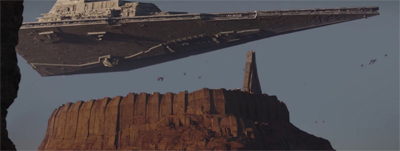
Above it all.
The Force Awakens arguably got away with this indulgent nostalgia because it was the first Star Wars film in over a decade. More than that, The Force Awakens was consciously intended to hark back to the original trilogy and to wash away the after-taste of the much-maligned prequel films. As such, the plot homages and cameos that littered The Force Awakens made a great deal of sense in the context of that particular film. In fact, they were a large part of the appeal.
Unfortunately, Rogue One does not have that excuse. The basic plot of the film should be continuity enough for this story. One of the primary appeals of the Star Wars universe as introduced in A New Hope is the sheer vastness of that fictional construct. The Star Wars universe feels expansive and developed, it seems like life goes on even outside of the individual frame or beyond the view of a given character. It is a universe of infinite possibilities and wonder, full of characters who have their own stories to tell.

Helmet by moonlight, proud Vader.
The biggest problem with Rogue One is an unwillingness to let these characters tell their own story without bluntly tying that narrative directly into the tale that we all know and love so well. These choices make the Star Wars franchise seem so much smaller than it once was, and even more incestuous than that time in A New Hope when Luke was really into Leia.
Filed under: Non-Review Reviews | Tagged: continuity, crossover, rogue one, rogue one - a star wars story, shared universe, star wars, war story |




















This review saddens me. I keep hoping for another really good Star Wars movie, but I have yet to get one. Truthfully, the only Star Wars movie that I truly like from beginning to end is Empire Strikes Back. Every other film has problems in varying degrees of severity. I think in terms of best to worst after Empire Strikes I would actually have to go with Revenge of the Sith, the second best, as it has some truly compelling ideas. The idea that Anakin would go evil to save someone he loves is fascinating, the idea that Jedi Order has become corrupt is also interesting, and the Emperor taking over in the name of security looks more and more realistic after current events in America. Of course, there is too much CGI and the love dialogue is bad, but it feels as if Revenge of the Sith had had just a better writer, then it could have been the best Star Wars film. After all, I still think the novel is best thing, Star Wars related, that I have read or seen. A New Hope is fun, but the dialogue is incredibly hokey at times and the acting can be spotty. After that, probably Return of the Jedi, in which I like the scenes with the Emperor, and really dislike everything else. The ewoks are annoying and the fact that they help to win the day is just so ridiculous. The use of the Death Star again, as I think they should have gone with a massive fleet battle though maybe that would have been too difficult. Still, the whole film reeks of laziness though not as much as the next offender.
Controversy ahead, but I did not like Star Wars: The Force Awakens at all. The plot was like a video game, and characters and concepts were poorly thought out. Why did Kylo Ren turn evil? Why did Finn turn good so quickly? How did Poe Dameron survive? Why is Rey so strong with the force after a day? How did the First Order take over? Why did Luke go into hiding? The one saving grace of the film, which is what elevates it over the first two prequels, is Harrison Ford. His fun curmudgeonly self makes the film bearable at times.
I don’t think I need to explain why the first two prequels are terrible, as that has been done to death.
Honestly, I think the best Star Wars media product, since Empire Strikes back, has to be the Clone Wars. They could devote much more time the characters, and the fight scenes could be dazzling.
The other thing that saddens me about this film is that it seems be continuing the trend of big budget films this year. The filmmaker has an idea that is promising, but thanks to studio interference the idea is lost in a muddle of a bunch of studio mandated stuff.
Yeah, I think 2016 is really the year where they drew down the shutter on the idea of finding another Christopher Nolan. For better or worse, he was really the post child for drafting in an “indie” or “unproven” film talent and having them helm a major tentpole. It seems like the past year or so has seen studios clamping down on that a bit, particularly with Edwards here, Ayer on Suicide Squad and Trank on Fantastic Four. Not that I’m claiming these films would have been masterpieces without studio interference, of course.
(This is why I cannot hate Batman vs. Superman, for its myriad flaws. It feels very much like a director who is doing what he wants to do, with nobody stopping him. It doesn’t really work, but I think the results are more interesting than the test-audience-focused adjustments that are being made to other big budget contemporary films.)
Why is there this love for Chris Nolan? Most of his films are garbage.
His films are accessible and well-made blockbusters that tackle big ideas in a manner that is far more engaging than most comparable filmmakers. I mean, he’s not perfect, but it’s a bit much to suggest that most of his films are garbage. I’d argue Memento, Batman Begins, The Prestige, The Dark Knight, and Inception are brilliant, and most of the rest are at the very least very good.
Those movies all suck though. They’re crappy, simplistic movies pretending to be something more. I don’t get why people in the internet age eat this shit up
‘Erasing the expanded universe from continuity was a good decision because it cleared out a whole host of incestuous clutter.’
*Begins sharpening a knife*
Personally I think I prefer the story more when it was called ‘Rebel Dawn’, the heroine was called Bria Tharen and Ann C. Crispin’s name was on the cover. Complete with shades of grey heroes executing captives.
(I honestly do like some of the new material but for all the supposed freshness modern Star Wars pretty shamelessly plunders the EU.)
Yes. I was always going to go in to the newniverse with some kind of a grudge given that the entire EU had to be thrown out for it. But even knowing that, there’s still something underwhelming about watching Episode VII and finding a standard Bantam-era superweapon-of-the-month story with the Solo family drama from Legacy of the Force wedged into it. Not only is it stuff that’s been done before, it’s not even the *good* stuff that was done before.
Still, as underwhelmed as I was, the newniverse has been more good than bad so far, and I’m hopeful as far as Rogue One goes. I’ll probably end up agreeing with you that I prefer Rebel Dawn (that book trilogy’s controversial, but I’m pretty firmly in the fan category), but that doesn’t mean the new story’ll be bad.
I mean, there are parts of the EU I like. I particularly like the Thrawn trilogy and the two or three Vader-centric miniseries that Dark Horse put out. But a lot of it falls into that tie-in fiction trap where everyone is either a chosen one or one degree of separation from somebody else. Sure, there’s more than enough time for this to happen again (and it probably will, given how Rebel One turns certain characters/elements into fetish objects), but it’s nice to start again without that sense of vines strangling the tree.
The only EU stuff I’ve ever experienced are some of the video games which are pretty cool. Star Wars as a whole is pretty lame, I like the original movies and some of the side material, but overall, it’s really lame and generic, and these latest films are especially so. To quote a youtuber, this latest one sucked space balls. VII was generic and meh. Improvement over the prequels but eh
In other words, fuck Star Wars
Mon Mothma wasn’t in “A New Hope”!
I’m seeing this on Friday night. With two friends, one named Luke and one whose son is named Luke. It is a very Star Wars world we live in.
You’re right!
I got my Death Stars mixed up! 🙂 Corrected.
I enjoyed this movie and the extended homages to A New Hope, but I agree that including so many established characters really distracted from the storyline. The ‘rebel base’ scenes were so distracting to me (“Hey! Is that Ackbar’s brother or something? Hey! It’s Jimmie Smits!”) that I barely followed the discussions going on. On the other hand, I did enjoy Vader’s two scenes in the movie.
Sao Garrera (spelling) seemed like a character with missed potential. They take the time to build him up, and then he…barely says anything, simply gives Jyn the information she needs, and dies immediately afterwards. Bodhi also seemed like he had a few scenes deleted that could have fleshed out a potentially interesting character.
After watching the film, my friends’ criticisms of the movie focused on the lack of character development in it. Personally, I didn’t mind that since I’m used to war movies, but I did feel like the movie knew it needed to set up all the pieces exactly in place for A New Hope, and kind of rushed to squeeze all those parts in very suddenly. It feels very similar to the end of Ep. III where everything had to fall into place just so to avoid any criticism of continuity failure or something: “Huh, I guess now we have to manage, in one movie, to kill all the Jedi, make Palpatine old, get Yoda on a swamp planet, turn Anakin into Darth Vader, and make C-3P0 forget all this.”
I actually thought the characters were quite good myself, although – as you point out – they did feel more like war movie characters than Star Wars movie characters. But I thought the cast was good enough and there was just enough material there to make them feel like more than just cyphers.
The characters were just walking stereotypes and cliches, I can’t remember any of their names. This movie actually physically annoyed me
I quite liked them, although I didn’t have a problem that they were largely archetypes. And I loved Krennic.
By that I mean I cringed a lot. Instead of developing characters with a personality, the vapid liberals behind the movie just created a bunch of boring ethnic stereotypes. I really..hate this film, unfortunately
The moment I saw a blind asian guy doing kung fu is when I turned my brain off. At least some of the characters died, that was a relief…
A relief that we don’t have to see these stupid characters again hopefully. I actually was rooting for the villain in the entire film, which I don’t think was the intentions of the film makers